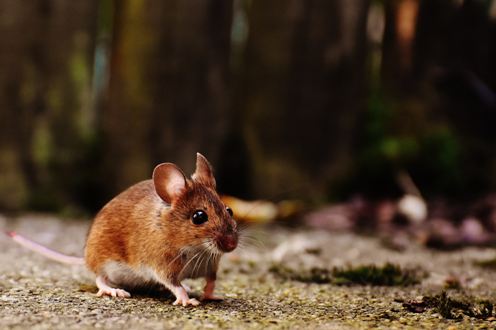While small animals including mice make up only 14% of the pets owned in the U.S., that doesn’t mean you should overlook these tiny rodents if you’re considering adding one to your household. Mice are remarkably intelligent and resourceful creatures. All species of mice—including unwanted ones that may get into your home—share the same traits.
Here are 11 fascinating facts about mice you may not have been aware of before. Some of these may even be enough to convince the mice phobic that these critters are actually really cool!
1. Mice Can Squeeze Through Ridiculously Small Spaces
We’re talking really small, like a hole as wide as a dime. Mice have a few things in their favor to help them accomplish this: they have no collarbones and they have long, narrow bodies (but not collapsible skeletons, which is a myth.) If their head can make it through an opening, the rest of their body can follow.
This is why it’s so easy for mice to enter a home through cracks in the foundation or small holes (and why sealing these up is important to keep them away.) A woodworker on YouTube set up a camera to demonstrate how amazingly well mice can pull themselves through tiny openings.
2. Mice Incisor Teeth Are Constantly Growing
Ever wonder why mice love to gnaw on anything they can get their little paws on? It’s because their incisor teeth, like those of many other types of rodents, are constantly growing. In fact, their teeth grow at a rate of 0.3 mm a day!
If our teeth grew that much daily we’d have a problem as well. So mice have to grind their choppers down by chewing on everything from cardboard to electrical wiring. If you have a mouse for a pet, you have to supply them with things they can safely chew on.
3. Mice Have Superhero Hearing
Mice actually have lousy vision, and see best in dim light. But because this one sense is diminished, it means their hearing is heightened. Mice can hear very high-frequency noises that humans can’t hear.
Mouse hearing is in the ultrasound frequencies. They can hear up to 90 kHz while humans usually cannot hear anything higher than 16 kHz. Mice communicate with each other at these high frequencies, including making “love calls” during the mating ritual.
4. Mice Can Learn How to Navigate Spaces
In addition to off-the-charts hearing, mice also possess superior senses of smell, taste, and touch. They can actually learn and memorize the locations of food, pathways, and obstacles in a space.
Mice are adept at exploring new spaces and will even learn how to hold their heads a certain way to access water and food. Read more here about mice learning classical conditioning techniques.
5. Mice Eat Several Times a Day
Mice have healthy appetites and will nosh on food up to 20 times a day. That means in the wild they build their homes close to food sources. If you keep a pet mouse, you’ll need to provide a supply of commercial mouse food, fresh fruits and veggies, and healthy treats such as chickpeas at all times.
6. Mouse Homes Are a Lot Like Ours
Did you know that mice like to build homes that contain separate areas for sleeping, food storage, and going to the bathroom? That isn’t unlike the way we like our households. Mice are also clean and tidy animals and will create burrows that have many tunnels and escape routes.
7. Mice Are Excellent Climbers
Mice can actually scale vertical walls if the surface has enough grip for them. They have no problem running up curtains and drain pipes. Once inside a home, it’s easy for them to access other floors and areas of a house.
8. Mice Are Even Better Jumpers
For such a small animal, mice can jump impressively high—leaps of over 25 cm have been recorded. They’re basically miniature gymnasts. The human equivalent for a six-foot-tall person would be jumping nearly 50 feet high!
In addition to climbing and jumping, mice are pretty good swimmers as well.
9. Mice Don’t Hibernate
Unlike other creatures, mice don’t hunker down and sleep during the winter. Instead, they like to seek out warm and cozy shelters, which is what drives them into people’s homes during the colder months. Just like most of us, they don’t like cold temperatures.
10. Mice Poop a Lot
This fact shouldn’t be surprising given their eating habits, but one mouse can produce between 40 and 100 droppings a day. If you keep one as a pet, you’ll need to swap out their bedding very regularly to keep their home fresh and clean.
11. Mice Can Reproduce Quickly
Mice mature fast, which is one reason why they can populate so quickly. A mouse can get pregnant when she’s only two months old, and give birth to up to a dozen baby mice every three weeks. If there were such a thing as mouse nurseries, they would constantly be busy!
This translates into one mouse having up to 150 offspring in one year. This is why if you choose a mouse for a pet, it’s advisable to only take one home. Not only do you reduce the risk of any friction, but you’ll avoid having to deal with mouse babies.
Now You Know Some Cool Facts About Mice
Now that you know these 11 fun facts about mice, maybe you’re considering adding one to your household? We forgot to mention that pet mice are cute and will keep you entertained for hours as you watch them scurry around their home!
Or maybe a hamster or rabbit is more your taste? Check out our small pets posts to learn more about the variety of adorable creatures you may want to bring home for a companion!

